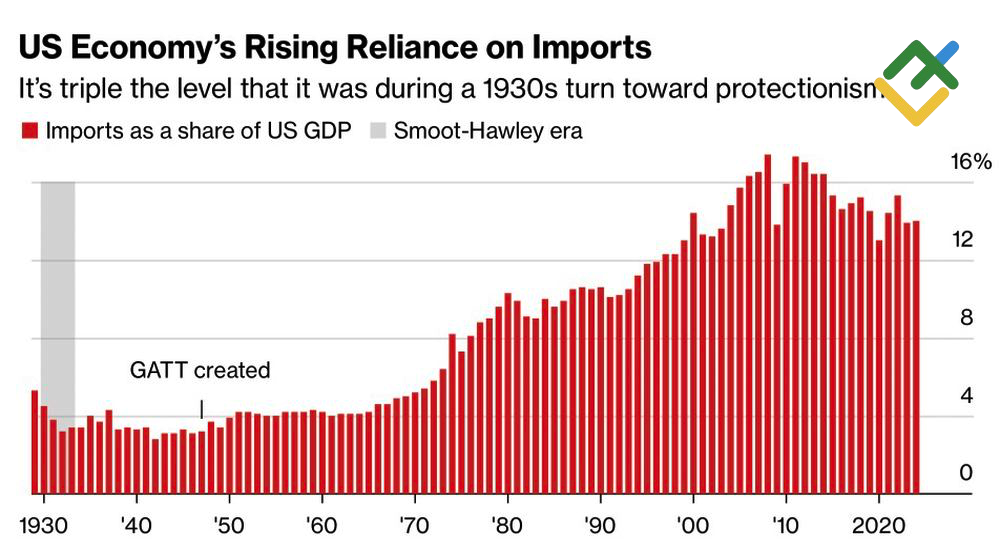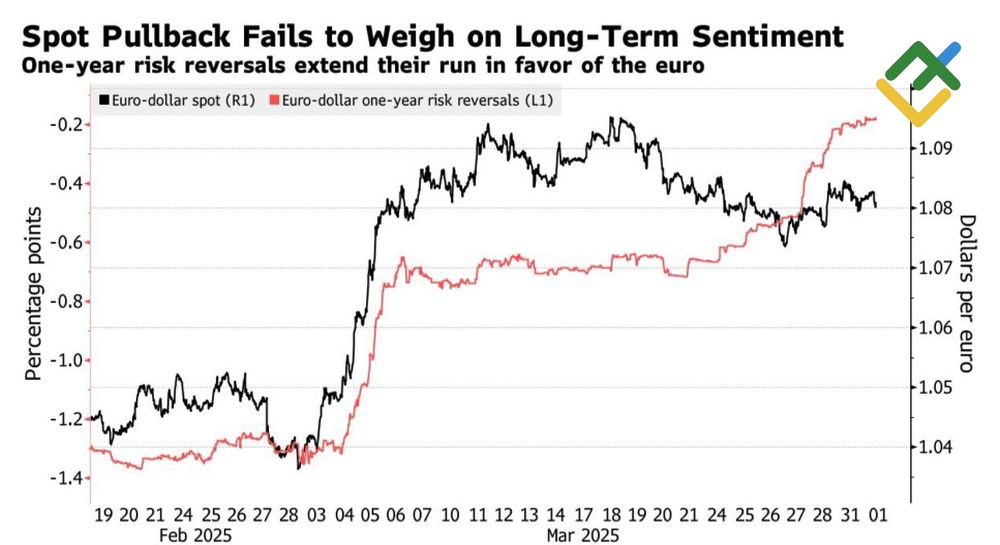
The EURUSD pair has not declined in response to tariff threats despite the anticipated negative impact on the EU economy. The US is in a precarious position. The US dollar’s position is likely to deteriorate regardless of Washington’s actions. Let’s discuss this topic and make a trading plan.
The article covers the following subjects:
Major Takeaways
- The euro’s trajectory hinges on US tariffs.
- The US economy continues to cool.
- Neither fiscal stimulus nor consolidation will help the US dollar.
- Traders may consider switching from short-term selling to buying.
Weekly US Dollar Fundamental Forecast
As America’s “Liberation Day” approaches, the market anticipates significant developments. On April 2, Donald Trump will announce tariffs that are expected to either rattle or calm the markets. The average tariff risks jumping from the current 2.2% to its highest level since the 1930s. Notably, imports currently account for 14% of the US GDP, which is three times the rate seen in the 1930s. The objective of these tariffs is to reduce the trade deficit, but will this strategy contribute to the resurgence of the American economy? Recent data suggests that this will not be the case, as evidenced by the EURUSD pair’s upside potential.
US Imports as a Share of GDP
Source: Bloomberg.
The US manufacturing PMI report for March is undoubtedly one of the most disappointing and stagflationary in years. The report indicates that business activity returned to below 50. The report used the terms “weak” 7 times, “slow” 21 times, and “tariff” 18 times. The economy is facing significant headwinds, and Richmond Fed President Thomas Barkin has expressed concerns that US duties on imports may spur inflation and unemployment. This could put the Fed in the position of having to make tough choices.
While the accuracy of this assessment is undeniable, for an extended period, financial markets have anticipated the emergence of a significant trade conflict between the US and the EU, forecasting its potential adverse impact on the eurozone economy. Not only is Brussels seen as a clear loser because of its trade surplus, but a slowdown in global GDP would also pose challenges for the export-oriented currency bloc.
However, Germany’s fiscal stimulus and the EU’s emphasis on defense will likely offset the adverse effects of tariffs. Conversely, the US lacks the financial resources to withstand a trade war. The Trump administration’s proposal to extend tax cuts is estimated to cost $4.5 trillion, to be financed by $2 trillion in budget cuts and $2.5 trillion in import duties, and these two figures are somewhat dubious.
The US will have to borrow, and borrowing from former allies will be extremely risky in the face of raging trade wars. This approach is likely to increase interest rates and decelerate GDP growth. However, reducing fiscal stimulus will also slow the economy. Washington is in a state of zugzwang, where each subsequent move exacerbates the existing situation.
EURUSD Performance and Risk Reversals
Source: Bloomberg.
As expected, the derivatives market is anticipating the EURUSD rally to continue, as evidenced by the risk reversals chart.
Weekly EURUSD Trading Plan
The major currency pair’s reaction to America’s “Liberation Day” depends on whether Donald Trump’s tariffs will shock or calm the financial markets. Nevertheless, the EURUSD pair maintains a bullish trend. As a result, traders may close their short-term short positions on a breakout of 1.078 and open long positions on a rebound from the support levels of 1.0725 and 1.069. Alternatively, if the quotes surge above the resistance level of 1.0845, one can open more long positions, adding them to the ones initiated in the range of 1.0735–1.0755.
This forecast is based on the analysis of fundamental factors, including official statements from financial institutions and regulators, various geopolitical and economic developments, and statistical data. Historical market data are also considered.
Price chart of EURUSD in real time mode
The content of this article reflects the author’s opinion and does not necessarily reflect the official position of LiteFinance broker. The material published on this page is provided for informational purposes only and should not be considered as the provision of investment advice for the purposes of Directive 2014/65/EU.
According to copyright law, this article is considered intellectual property, which includes a prohibition on copying and distributing it without consent.
{{value}} ( {{count}} {{title}} )
This post is originally published on LITEFINANCE.





